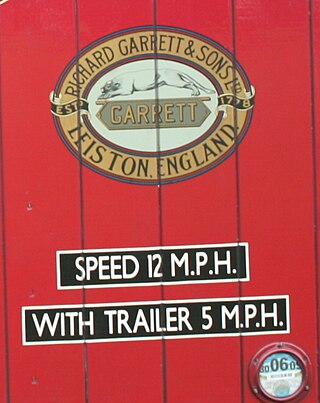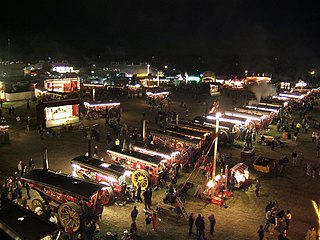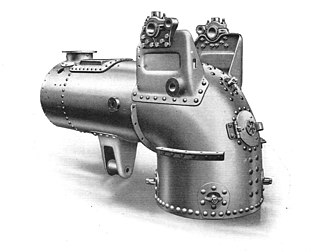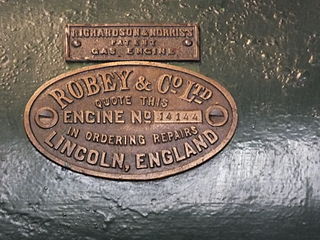
Continuous track is a system of vehicle propulsion used in tracked vehicles, running on a continuous band of treads or track plates driven by two or more wheels. The large surface area of the tracks distributes the weight of the vehicle better than steel or rubber tyres on an equivalent vehicle, enabling continuous tracked vehicles to traverse soft ground with less likelihood of becoming stuck due to sinking.

A traction engine is a steam-powered tractor used to move heavy loads on roads, plough ground or to provide power at a chosen location. The name derives from the Latin tractus, meaning 'drawn', since the prime function of any traction engine is to draw a load behind it. They are sometimes called road locomotives to distinguish them from railway locomotives – that is, steam engines that run on rails.

Aveling and Porter was a British agricultural engine and steamroller manufacturer. Thomas Aveling and Richard Thomas Porter entered into partnership in 1862, and developed a steam engine three years later in 1865. By the early 1900s, the company had become the largest manufacturer of steamrollers in the world. The company used a rampant horse as its logo derived from the White Horse of Kent.

William Foster & Co Ltd was an agricultural machinery company based in Lincoln, Lincolnshire, England often called "Fosters of Lincoln." The company can be traced back to 1846, when William Foster purchased a flour mill in Lincoln. William Foster then proceeded to start small scale manufacturing of mill machinery and threshing machinery. The mill was converted to an iron foundry by 1856, thus becoming the original Wellington Foundry. By 1899 the works had moved to the Wellington foundry in New Boultham and the original works were then occupied by William Rainforth. During the First World War Fosters built some of the first tanks for the British Army.
Scammell Lorries Limited was a British manufacturer of trucks, particularly specialist and military off-highway vehicles, between 1921 and 1988.

A steam tractor is a vehicle powered by a steam engine which is used for pulling.

A portable engine is an engine, either a steam engine or an internal combustion engine, that sits in one place while operating, but is portable and thus can be easily moved from one work site to another. Mounted on wheels or skids, it is either towed to the work site or moves there via self-propulsion.

Richard Garrett & Sons was a manufacturer of agricultural machinery, steam engines and trolleybuses. Their factory was Leiston Works, in Leiston, Suffolk, England. The company was founded by Richard Garrett in 1778.

J&H McLaren was a British engineering company in Hunslet, Leeds, England, that manufactured traction engines, stationary engines and later, diesel engines.
The Strumpshaw Hall Steam Museum in Strumpshaw, Norfolk is home to a collection of Traction engines, Steam rollers, a Showman's engine and a Steam wagon which are run on special occasions and on the last Sunday of each month from April to October.

A showman's road locomotive or showman's engine is a steam-powered road-going 'locomotive' designed to provide power and transport for a travelling funfair or circus. Similar to other road-going traction engines, showman's engines were normally distinguished by the addition of a full-length canopy, a dynamo mounted in front of the chimney, and brightly coloured paintwork with ornate decorations. The dynamo was used to generate electricity to illuminate and power various fairground rides. Although originally the ride's motion was powered by an internal steam engine, some later rides were driven direct from the showman's engine via a belt drive.

A steam wagon is a steam-powered truck for carrying freight. It was the earliest form of lorry (truck) and came in two basic forms: overtype and undertype, the distinction being the position of the engine relative to the boiler. Manufacturers tended to concentrate on one form or the other.
James Boydell was a British inventor of steam traction engines. His most significant invention was the first practical track-laying vehicle, for which he received British patents in August 1846 and February 1854.

A pistol boiler is a design of steam boiler used in light steam tractors and overtype steam wagons. It is noted for the unusual shape of the firebox, a circular design intended to be self-supporting without the use of firebox stays.

James & Fred Howard of Britannia Ironworks, Bedford, later known simply as Howards, were one of the largest English makers of agricultural equipment, steam traction engines, and light railway equipment. At The Great Exhibition of 1851 they exhibited a range of horse-drawn implements. After World War I, Howards became part of AGE, Agricultural & General Engineers, along with many of the other British makers of similar machinery.

A dreadnaught wheel is a wheel with articulated rails attached at the rim to provide a firm footing for the wheel to roll over. These wheels have also been known as "endless railway wheels" when fitted to road locomotives, and were commonly fitted to steam traction engines. They are very similar to pedrail wheels, differing primarily in that their rails are not connected to the wheel directly, but articulated to each other.

The Charles Burrell Museum is a museum in Thetford in Norfolk, England, dedicated to steam power and steam transport.
The John Fowler 7nhp Steam Road Locomotive is a heritage-listed former steam road locomotive with nominal power of 5.2 kilowatts (7 hp) and now exhibited at 9 Amaroo Drive, Wellington, in the Dubbo Regional Council local government area of New South Wales, Australia. It was designed and built by John Fowler & Co. (Leeds) Ltd in 1912. The property is owned by the Dubbo Regional Council and it was added to the New South Wales State Heritage Register on 18 November 2011.

Robey and Co. was an engineering company based in Lincoln, Lincolnshire, England which can be traced back to around 1849.























